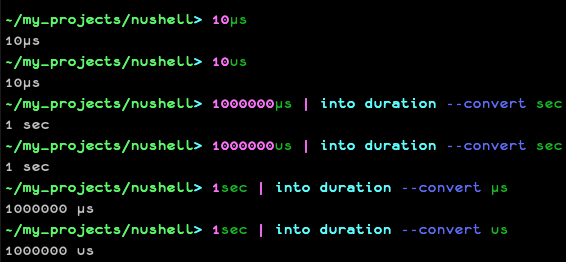# Description This is to resolve the issue [8614](https://github.com/nushell/nushell/issues/8614). It allows the parsing of the mu (µ) character for durations, so you can type `10µs`, and it correctly outputs, whilst maintaining the current `us` parsing as well. It also forces `durations` to be entered in lower case.  (The bottom one `1sec | into duration --convert us` looks like an existing bug, where converting to `us` outputs `us` rather than `µs`) # User-Facing Changes Allows the user to parse durations in µs Forces `durations` to be entered in lower case rather than any case, and will error if not in lower case. # Tests + Formatting Don't forget to add tests that cover your changes. Make sure you've run and fixed any issues with these commands: - `cargo fmt --all -- --check` to check standard code formatting (`cargo fmt --all` applies these changes) - `cargo clippy --workspace -- -D warnings -D clippy::unwrap_used -A clippy::needless_collect` to check that you're using the standard code style - `cargo test --workspace` to check that all tests pass > **Note** > from `nushell` you can also use the `toolkit` as follows > ```bash > use toolkit.nu # or use an `env_change` hook to activate it automatically > toolkit check pr > ``` # After Submitting If your PR had any user-facing changes, update [the documentation](https://github.com/nushell/nushell.github.io) after the PR is merged, if necessary. This will help us keep the docs up to date. --------- Co-authored-by: Stefan Holderbach <sholderbach@users.noreply.github.com>
nu-parser, the Nushell parser
Nushell's parser is a type-directed parser, meaning that the parser will use type information available during parse time to configure the parser. This allows it to handle a broader range of techniques to handle the arguments of a command.
Nushell's base language is whitespace-separated tokens with the command (Nushell's term for a function) name in the head position:
head1 arg1 arg2 | head2
Lexing
The first job of the parser is to a lexical analysis to find where the tokens start and end in the input. This turns the above into:
<item: "head1">, <item: "arg1">, <item: "arg2">, <pipe>, <item: "head2">
At this point, the parser has little to no understanding of the shape of the command or how to parse its arguments.
Lite parsing
As Nushell is a language of pipelines, pipes form a key role in both separating commands from each other as well as denoting the flow of information between commands. The lite parse phase, as the name suggests, helps to group the lexed tokens into units.
The above tokens are converted the following during the lite parse phase:
Pipeline:
Command #1:
<item: "head1">, <item: "arg1">, <item: "arg2">
Command #2:
<item: "head2">
Parsing
The real magic begins to happen when the parse moves on to the parsing stage. At this point, it traverses the lite parse tree and for each command makes a decision:
- If the command looks like an internal/external command literal: e.g.
fooor/usr/bin/ls, it parses it as an internal or external command - Otherwise, it parses the command as part of a mathematical expression
Types/shapes
Each command has a shape assigned to each of the arguments it reads in. These shapes help define how the parser will handle the parse.
For example, if the command is written as:
where $x > 10
When the parsing happens, the parser will look up the where command and find its Signature. The Signature states what flags are allowed and what positional arguments are allowed (both required and optional). Each argument comes with a Shape that defines how to parse values to get that position.
In the above example, if the Signature of where said that it took three String values, the result would be:
CallInfo:
Name: `where`
Args:
Expression($x), a String
Expression(>), a String
Expression(10), a String
Or, the Signature could state that it takes in three positional arguments: a Variable, an Operator, and a Number, which would give:
CallInfo:
Name: `where`
Args:
Expression($x), a Variable
Expression(>), an Operator
Expression(10), a Number
Note that in this case, each would be checked at compile time to confirm that the expression has the shape requested. For example, "foo" would fail to parse as a Number.
Finally, some Shapes can consume more than one token. In the above, if the where command stated it took in a single required argument, and that the Shape of this argument was a MathExpression, then the parser would treat the remaining tokens as part of the math expression.
CallInfo:
Name: `where`
Args:
MathExpression:
Op: >
LHS: Expression($x)
RHS: Expression(10)
When the command runs, it will now be able to evaluate the whole math expression as a single step rather than doing any additional parsing to understand the relationship between the parameters.
Making space
As some Shapes can consume multiple tokens, it's important that the parser allow for multiple Shapes to coexist as peacefully as possible.
The simplest way it does this is to ensure there is at least one token for each required parameter. If the Signature of the command says that it takes a MathExpression and a Number as two required arguments, then the parser will stop the math parser one token short. This allows the second Shape to consume the final token.
Another way that the parser makes space is to look for Keyword shapes in the Signature. A Keyword is a word that's special to this command. For example in the if command, else is a keyword. When it is found in the arguments, the parser will use it as a signpost for where to make space for each Shape. The tokens leading up to the else will then feed into the parts of the Signature before the else, and the tokens following are consumed by the else and the Shapes that follow.